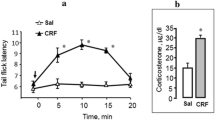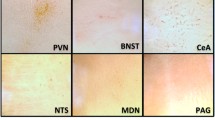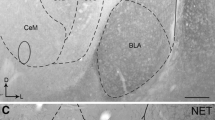Abstract
Rationale
Hypersecretion of corticotropin releasing factor (CRF) has been implicated in both severe anxiety disorders and major depression. Although the role of the CRF1 receptor in the anxiogenic effects of CRF is well supported, the role of CRF2 receptors in anxiety-like behaviors is less clear. In rats, CRF increases the acoustic startle reflex (ASR) via its action in the extended amygdala, providing a putative measure of CRF-mediated anxiogenic activity.
Objective
To characterize the effect of CRF on ASR in mice and determine the respective roles of CRF1 and CRF2 receptors in CRF-potentiated ASR.
Methods
The present study examined: (1) the time course and dose response functions for the effects of human/rat (h/r)-CRF (0.02–0.6 nmol, ICV (intracerebroventricular)) on ASR in two inbred strains of mice; (2) the effects of the CRF1 receptor antagonist NBI-30775 (20 mg/kg, intraperitoneal) and the CRF2 receptor antagonist Antisauvagine-30 (1–10 nmol, ICV) on CRF-potentiated ASR and (3) the effects of the CRF2 receptor agonist urocortin 2 (0.2–6 nmol, ICV) on ASR in mice.
Results
h/r-CRF significantly increased ASR in mice in a time-dependent manner with maximal efficacy at the 0.2 and 0.6 nmol doses. 129S6/SvEvTac mice exhibited a slightly increased duration of action and lower minimal effective dose threshold for CRF effects on ASR compared to C57BL/6J mice. Both selective CRF1 and CRF2 antagonists attenuated h/r-CRF-potentiated ASR without affecting acoustic startle when given alone. The selective CRF2 receptor agonist urocortin 2 increased ASR (1 and 2 nmol), albeit with less efficacy than the non-selective CRF receptor agonist h/r-CRF.
Conclusions
Both CRF1 and CRF2 receptors appear to contribute to the h/r-CRF-induced increases in ASR in mice. These data support the hypothesis that both receptors contribute to the anxiogenic effects of CRF.






Similar content being viewed by others
References
Bakshi VP, Kalin NH (2000) Corticotropin-releasing hormone and animal models of anxiety: gene-environment interactions. Biol Psychiatry 48:1175–1198
Bakshi VP, Smith-Roe S, Newman SM, Grigoriadis DE, Kalin NH (2002) Reduction of stress-induced behavior by antagonism of corticotropin-releasing hormone 2 (CRH2) receptors in lateral septum or CRH1 receptors in amygdala. J Neurosci 22:2926–2935
Bale TL, Contarino A, Smith GW, Chan R, Gold LH, Sawchenko PE, Koob GF, Vale WW, Lee KF (2000) Mice deficient for corticotropin-releasing hormone receptor-2 display anxiety-like behaviour and are hypersensitive to stress. Nat Genet 24:410–414
Bale TL, Picetti R, Contarino A, Koob GF, Vale WW, Lee KF (2002) Mice deficient for both corticotropin-releasing factor receptor 1 (CRFR1) and CRFR2 have an impaired stress response and display sexually dichotomous anxiety-like behavior. J Neurosci 22:193–199
Bittencourt JC, Sawchenko PE (2000) Do centrally mediated neuropeptides access cognate receptors?: an analysis in the central corticotropin-releasing factor system. J Neurosci 20:1142–1156
Blank T, Nijholt I, Grammatopoulos DK, Randeva HS, Hillhouse EW, Spiess J (2003) Corticotropin-releasing factor receptors couple to multiple G-proteins to activate diverse intracellular signaling pathways in mouse hippocampus: role in neuronal excitability and associative learning. J Neurosci 23:700–707
Brauns O, Liepold T, Radulovic J, Spiess J (2001) Pharmacological and chemical properties of astressin, antisauvagine-30 and alpha-helical CRF: significance for behavioral experiments. Neuropharmacology 41:507–516
Butler RW, Braff DL, Rausch JL, Jenkins MA, Sprock J, Geyer MA (1990) Physiological evidence of exaggerated startle response in a subgroup of Vietnam veterans with combat-related PTSD. Am J Psychiatry 147:1308–1312
Cohen J (1988) Statistical Power Analysis for the Behavioral Sciences, 2nd edn. Erlbaum, Hillsdale, N.J.
Conti LH, Costello DG, Martin LA, White MF, Abreu ME (1994) Mouse strain differences in the behavioral effects of corticotropin-releasing factor (CRF) and the CRF antagonist alpha-helical CRF9–41. Pharmacol Biochem Behav 48:497–503
Coste SC, Murray SE, Stenzel-Poore MP (2001) Animal models of CRH excess and CRH receptor deficiency display altered adaptations to stress. Peptides 22:733–741
Dautzenberg FM, Hauger RL (2002) The CRF peptide family and their receptors: yet more partners discovered. Trends Pharmacol Sci 23:71–77
Davis M (1998) Are different parts of the extended amygdala involved in fear versus anxiety? Biol Psychiatry 44:1239–1247
Davis M, Falls WA, Campeau S, Kim M (1993) Fear-potentiated startle: a neural and pharmacological analysis. Behav Brain Res 58:175–198
Davis M, Walker DL, Lee Y (1997) Roles of the amygdala and bed nucleus of the stria terminalis in fear and anxiety measured with the acoustic startle reflex. Possible relevance to PTSD. Ann NY Acad Sci 821:305–331
Dulawa SC, Grandy DK, Low MJ, Paulus MP, Geyer MA (1999) Dopamine D4 receptor-knock-out mice exhibit reduced exploration of novel stimuli. J Neurosci 19:9550–9556
Fendt M, Fanselow MS (1999) The neuroanatomical and neurochemical basis of conditioned fear. Neurosci Biobehav 23:743–760
Graeff FG, Silveira MC, Nogueira RL, Audi EA, Oliveira RM (1993) Role of the amygdala and periaqueductal gray in anxiety and panic. Behav Brain Res 58:123–131
Griebel G, Perrault G, Sanger DJ (1998) Characterization of the behavioral profile of the non-peptide CRF receptor antagonist CP-154,526 in anxiety models in rodents. Comparison with diazepam and buspirone. Psychopharmacology 138:55–66
Grigoriadis DE, Chen C, Wilcoxen K, Chet T, Lorang MT, Bozigion H, Lia X-J, Ling N, McCarthy JR, De Souza EB, Vale WW (2000) In vitro characterization of R121292: a novel non-peptide corticotropin-releasing factor1 (CRF1) receptor antagonist for the potential treatment of depression and anxiety-related disorders. Soc Neurosci Abstr 807:4–9
Grigoriadis D, Haddach M, Ling N, Saunders J (2001) The CRF receptor: structure, function and potential for therapeutic intervention. Curr Med Chem-CNS Agents 1:63–97
Grillon C (2002) Associative learning deficits increase symptoms of anxiety in humans. Biol Psychiatry 51:958–975
Grillon C, Morgan CA 3rd (1999) Fear-potentiated startle conditioning to explicit and contextual cues in Gulf War veterans with posttraumatic stress disorder. J Abnorm Psychol 108:134–142
Grillon C, Morgan CA 3rd, Davis M, Southwick SM (1998) Effects of experimental context and explicit threat cues on acoustic startle in Vietnam veterans with posttraumatic stress disorder. Biol Psychiatry 44:1027–1036
Gutman DA, Owens MJ, Skelton KH, Thrivikrama KV, Nemeroff CB (2003) The corticotropin-releasing factor1 receptor antagonist R121919 attenuates the behavioral and endocrine responses to stress. J Pharmacol Exp Ther 304:874–880
Habib KE, Weld KP, Rice KC, Pushkas J, Champoux M, Listwak S, Webster EL, Atkinson AJ, Schulkin J, Contoreggi C, Chrousos GP, McCann SM, Suomi SJ, Higley JD, Gold PW (2000) Oral administration of a corticotropin-releasing hormone receptor antagonist significantly attenuates behavioral, neuroendocrine, and autonomic responses to stress in primates. Proc Natl Acad Sci USA 97:6079–6084
Heinrichs SC, De Souza EB, Schulteis G, Lapsansky JL, Grigoriadis DE (2002) Brain penetrance, receptor occupancy and antistress in vivo efficacy of a small molecule corticotropin releasing factor type I receptor selective antagonist. Neuropsychopharmacology 27:194–202
Heldt S, Sundin V, Willott JF, Falls WA (2000) Posttraining lesions of the amygdala interfere with fear-potentiated startle to both visual and auditory conditioned stimuli in C57BL/6J mice. Behav Neurosci 114:749–759
Higelin J, Py-Lang G, Paternoster C, Ellis GJ, Patel A, Dautzenberg FM (2001) 125I-Antisauvagine-30: a novel and specific high affinity radioligand for the characterization of corticotropin-releasing factor type 2 receptors. Neuropharmacology 40:114–122
Ho SP, Takahashi LK, Livanov V, Spencer K, Lesher T, Maciag C, Smith MA, Rohrbach KW, Hartig PR, Arneric SP (2001) Attenuation of fear conditioning by antisense inhibition of brain corticotropin releasing factor-2 receptor. Brain Res Mol Brain 89:29–40
Jones DN, Kortekaas R, Slade PD, Middlemiss DN, Hagan JJ (1998) The behavioural effects of corticotropin-releasing factor-related peptides in rats. Psychopharmacology 138:124–132
Keck ME, Welt T, Wigger A, Renner U, Engelmann M, Holsboer F, Landgraf R (2001) The anxiolytic effect of the CRH(1) receptor antagonist R121919 depends on innate emotionality in rats. Eur J Neurosci 13:373–380
Kishimoto T, Radulovic J, Radulovic M, Lin CR, Schrick C, Hooshmand F, Hermanson O, Rosenfeld MG, Spiess J (2000) Deletion of crhr2 reveals an anxiolytic role for corticotropin-releasing hormone receptor-2. Nat Genet 24:415–419
Koob GF, Heinrichs SC (1999) A role for corticotropin releasing factor and urocortin in behavioral responses to stressors. Brain Res 848:141–152
Lang PJ, Davis M, Ohman A (2000) Fear and anxiety: animal models and human cognitive psychophysiology. J Affect Disord 61:137–159
Liang KC, Melia KR, Miserendino MJ, Falls WA, Campeau S, Davis M (1992) Corticotropin-releasing factor: long-lasting facilitation of the acoustic startle reflex. J Neurosci 12:2303–2312
Liebsch G, Landgraf R, Engelmann M, Lörscher P, Hoslboer F (1999) Differential behavioural effects of chronic infusion of CRH1 and CRH2 receptor antisense oligonucleotides into the rat brain. J Psychiatr Res 33:153–163
Lovenberg TW, Liaw CW, Grigoriadis DE, Clevenger W, Chalmers DT, De Souza EB, Oltersdorf T (1995) Cloning and characterization of a functionally distinct corticotropin-releasing factor receptor subtype from rat brain. Proc Natl Acad Sci USA 92:836–840
Lundkvist J, Chai Z, Teheranian R, Hasanvan H, Bartfai T, Jenck F, Widmer U, Moreau JL (1996) A non peptidic corticotropin releasing factor receptor antagonist attenuates fever and exhibits anxiolytic-like activity. Eur J Pharmacol 309:195–200
Mansbach RS, Geyer MA (1988) Blockade of potentiated startle responding in rats by 5-hydroxytryptamine1A receptor ligands. Eur J Pharmacol 156:375–383
Nemeroff CB (2002) New directions in the development of antidepressants: the interface of neurobiology and psychiatry. Hum Psychopharmacol 17:13–16
Pelleymounter MA, Joppa M, Carmouche M, Cullen MJ, Brown B, Murphy B, Grigoriadis DE, Ling N, Foster AC (2000) Role of corticotropin-releasing factor (CRF) receptors in the anorexic syndrome induced by CRF. J Pharmacol Exp Ther 293:799–806
Pelleymounter MA, Joppa M, Ling N, Foster AC (2002) Pharmacological evidence supporting a role for central corticotropin-releasing factor(2) receptors in behavioral, but not endocrine, response to environmental stress. J Pharmacol Exp Ther 302:145–152
Perrin MH, Vale W (2002) Chapter 25: Corticotropin-releasing factor receptors. In: Pangalos MN, Davies CH (eds) Understanding G protein-coupled receptors and their role in the CNS. Oxford University Press, New York, pp 505–526
Radulovic J, Ruhmann A, Liepold T, Spiess J (1999) Modulation of learning and anxiety by corticotropin-releasing factor (CRF) and stress: differential roles of CRF receptors 1 and 2. J Neurosci 19:5016–5025
Reul JM, Holsboer F (2002) Corticotropin-releasing factor receptors 1 and 2 in anxiety and depression. Curr Opin Pharmacol 2:23–33
Reyes TM, Lewis K, Perrin MH, Kunitake KS, Vaughan J, Arias CA, Hogenesch JB, Gulyas J, Rivier J, Vale WW, Sawchenko PE (2001) Urocortin II: a member of the corticotropin-releasing factor (CRF) neuropeptide family that is selectively bound by type 2 CRF receptors. Proc Natl Acad Sci USA 98:2843–2848
Risbrough VB, Brodkin JD, Geyer MA (2003) GABA-A and 5-HT1A receptor agonists block expression of fear-potentiated startle in mice. Neuropsychopharmacology 28:654–663
Ruhmann A, Bonk I, Lin CR, Rosenfeld MG, Spiess J (1998) Structural requirements for peptidic antagonists of the corticotropin-releasing factor receptor (CRFR): development of CRFR2β-selective antisauvagine-30. Proc Natl Acad Sci USA 95:15264–15269
Schulz DW, Mansbach RS, Sprouse J, Braselton JP, Collins J, Corman M, Dunaiskis A, Faraci S, Schmidt AW, Seeger T, Seymour P, Tingley FD III, Winston EN, Chen YL, Heym J (1996) CP-154,526: a potent and selective nonpeptide antagonist of corticotropin releasing factor receptors. Proc Natl Acad Sci USA 93:10477–10482
Skutella T, Probst JC, Renner U, Hoslboer F, Behl C (1998) Corticotropin-releasing hormone receptor (type 1) antisense targeting reduces anxiety. Neuroscience 85:795–805
Smith GW, Aubry JM, Dellu F, Contarino A, Bilezikjian LM, Gold LH, Chen R, Marchuk Y, Hauser C, Bentley CA, Sawchenko PE, Koob GF, Vale W, Lee KF (1998) Corticotropin releasing factor receptor 1-deficient mice display decreased anxiety, impaired stress response, and aberrant neuroendocrine development. Neuron 20:1093–1102
Spina M, Merlo-Pich E, Chan RK, Basso AM, Rivier J, Vale W, Koob GF (1996) Appetite-suppressing effects of urocortin, a CRF-related neuropeptide. Science 273:1561–1564
Swerdlow NR, Geyer MA, Vale WW, Koob GF (1986) Corticotropin-releasing factor potentiates acoustic startle in rats: blockade by chlordiazepoxide. Psychopharmacology 88:147–152
Swerdlow NR, Britton KT, Koob GF (1989) Potentiation of acoustic startle by corticotropin-releasing factor (CRF) and by fear are both reversed by alpha-helical CRF (9–41). Neuropsychopharmacology 2:285–292
Takahashi LK, Ho SP, Livanov V, Graciani N, Arneric SP (2001) Antagonism of CRF(2) receptors produces anxiolytic behavior in animal models of anxiety. Brain Res 902:135–142
Valdez GR, Inoue K, Koob GF, Rivier J, Vale W, Zorrilla EP (2002) Human urocortin II: mild locomotor suppressive and delayed anxiolytic-like effects of a novel corticotropin-releasing factor related peptide. Brain Res 943:142–150
Vale W, Spiess J, Rivier C, Rivier J (1981) Characterization of a 41-residue ovine hypothalamic peptide that stimulates secretion of corticotropin and beta-endorphin. Science 213:1394–1397
Van Pett K, Viau V, Bittencourt JC, Chan RK, Li HY, Arias C, Prins GS, Perrin M, Vale W, Sawchenko PE (2000) Distribution of mRNAs encoding CRF receptors in brain and pituitary of rat and mouse. J Comp Neurol 428:191–212
Walker DL, Davis M (2002) Quantifying fear potentiated startle using absolute versus proportional increase scoring methods: implications for the neurocircuitry of fear and anxiety. Psychopharmacology 164:318–328
Walker DL, Cassella JV, Lee Y, De Lima TC, Davis M (1997) Opposing roles of the amygdala and dorsolateral periaqueductal gray in fear-potentiated startle. Neurosci Biobehav Rev 21:743–753
Acknowledgements
The authors thank Drs. Dimitri Grigoriadis and Alan Foster of Neurocrine Biosciences for the CRF antagonists and their helpful comments and suggestions throughout the experimental and manuscript processes. We thank Frank Dautzenberg for his constructive review of the manuscript and Margaret Joppa for invaluable instruction on ICV injections. We are also grateful to Jonathon Stroebel, Sara Tehrani, Sorana Caldwell, and Katrina Paumier for technical assistance. This research was supported by the US Veterans Affairs VISN 22 Mental Illness Research, Education, and Clinical Center (MIRECC; M.A.G. and R.L.H.), a VA Merit Review grant (R.L.H.), a MERCK NEP fellowship and an NIMH National Research Service Award (V.B.R.), and the National Institute on Drug Abuse [DA02925 (M.A.G.) and DA13769–01 (R.L.H.)].
Author information
Authors and Affiliations
Corresponding author
Rights and permissions
About this article
Cite this article
Risbrough, V.B., Hauger, R.L., Pelleymounter, M.A. et al. Role of corticotropin releasing factor (CRF) receptors 1 and 2 in CRF-potentiated acoustic startle in mice. Psychopharmacology 170, 178–187 (2003). https://doi.org/10.1007/s00213-003-1535-6
Received:
Accepted:
Published:
Issue Date:
DOI: https://doi.org/10.1007/s00213-003-1535-6




